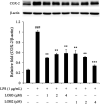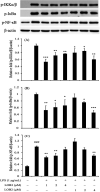Flaxseed orbitides, linusorbs, inhibit LPS-induced THP-1 macrophage inflammation
- PMID: 35514549
- PMCID: PMC9054600
- DOI: 10.1039/c9ra09058d
Flaxseed orbitides, linusorbs, inhibit LPS-induced THP-1 macrophage inflammation
Abstract
Linusorbs (flaxseed orbitides) are a family of naturally-occurring cyclic peptides. Previously, we reported that their anticancer effects were associated with their structures. In this study, we investigated the anti-inflammatory activities of 2 different linusorbs ([1-9-NαC]-linusorb B2 and [1-9-NαC]-linusorb B3) in lipopolysaccharide (LPS)-induced THP-1 macrophage activation as well as the underlying mechanism of this inflammatory response. Both molecules suppressed pro-inflammatory mediators (TNF-α, IL-1β, IL-6, NO and COX-2) and were involved in downregulating the NF-κB signaling pathway. The suppressive effects on pro-inflammatory mediators were comparable and the concentration range of action was similar (1-4 μM). However, the concentration of compound that induced downregulation of the NF-κB pathway was different for each compound. While [1-9-NαC]-linusorb B3 could inhibit the activation of the NF-κB pathway at concentrations of 1 and 2 μM, [1-9-NαC]-linusorb B2 induced a comparable inhibitory effect at a concentration of 4 μM.
This journal is © The Royal Society of Chemistry.
Conflict of interest statement
There are no conflicts of interest to declare. Dr Martin J. T. Reaney is the founder of, and has an equity interest in, PTD (Saskatoon, SK, Canada: previous company name is Prairie Tide Chemicals Inc.). Dr Youn Young Shim is a Market Consultant for PTD. The terms of this arrangement have been reviewed and approved by the University of Saskatchewan (Saskatoon, SK, Canada) in accordance with its conflict of interest policies.
Figures






Similar articles
-
Uptake of Flaxseed Dietary Linusorbs Modulates Regulatory Genes Including Induction of Heat Shock Proteins and Apoptosis.Foods. 2022 Nov 22;11(23):3761. doi: 10.3390/foods11233761. Foods. 2022. PMID: 36496568 Free PMC article.
-
Non-oxidized and oxidized flaxseed orbitides differently induce HepG2 cell apoptosis: involvement of cellular uptake and membrane death receptor DR4.J Sci Food Agric. 2024 May;104(7):4296-4308. doi: 10.1002/jsfa.13315. Epub 2024 Mar 3. J Sci Food Agric. 2024. PMID: 38433335
-
A novel formulation significantly increases the cytotoxicity of flaxseed orbitides (linusorbs) LOB3 and LOB2 towards human breast cancer MDA-MB-231 cells.Pharmazie. 2019 Sep 1;74(9):520-522. doi: 10.1691/ph.2019.9055. Pharmazie. 2019. PMID: 31484590
-
Evaluating the cytotoxicity of flaxseed orbitides for potential cancer treatment.Toxicol Rep. 2015 Jul 13;2:1014-1018. doi: 10.1016/j.toxrep.2015.06.011. eCollection 2015. Toxicol Rep. 2015. PMID: 28962442 Free PMC article.
-
The Anti-Inflammatory Mechanism of Flaxseed Linusorbs on Lipopolysaccharide-Induced RAW 264.7 Macrophages by Modulating TLR4/NF-κB/MAPK Pathway.Foods. 2023 Jun 16;12(12):2398. doi: 10.3390/foods12122398. Foods. 2023. PMID: 37372610 Free PMC article.
Cited by
-
Oxidative Stability of Novel Peptides (Linusorbs) in Flaxseed Meal-Fortified Gluten-Free Bread.Foods. 2025 Jan 29;14(3):439. doi: 10.3390/foods14030439. Foods. 2025. PMID: 39942031 Free PMC article.
-
Development and Challenges of Cyclic Peptides for Immunomodulation.Curr Protein Pept Sci. 2024;25(5):353-375. doi: 10.2174/0113892037272528231030074158. Curr Protein Pept Sci. 2024. PMID: 37990433 Review.
-
Uptake of Flaxseed Dietary Linusorbs Modulates Regulatory Genes Including Induction of Heat Shock Proteins and Apoptosis.Foods. 2022 Nov 22;11(23):3761. doi: 10.3390/foods11233761. Foods. 2022. PMID: 36496568 Free PMC article.
-
Utilizing the healing power of flaxseed: a narrative review of its therapeutic applications.J Diabetes Metab Disord. 2025 May 28;24(1):128. doi: 10.1007/s40200-025-01636-2. eCollection 2025 Jun. J Diabetes Metab Disord. 2025. PMID: 40454185 Review.
-
Plant peptides - redefining an area of ribosomally synthesized and post-translationally modified peptides.Nat Prod Rep. 2024 Jul 17;41(7):1020-1059. doi: 10.1039/d3np00042g. Nat Prod Rep. 2024. PMID: 38411572 Free PMC article. Review.
References
LinkOut - more resources
Full Text Sources
Research Materials

